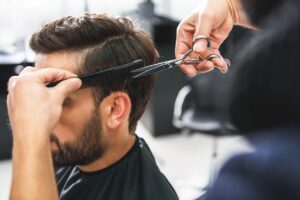Hair loss is one of those things most men hope they’ll never have to deal with—but for many, it’s an unavoidable reality. If you’ve noticed your hairline creeping back or your crown thinning, you’re not alone. By age 50, about 85% of men will experience some degree of hair loss. But why does it happen, and more importantly, what can you do about it?
Why Do Men Lose Their Hair?
The most common culprit behind male hair loss is androgenetic alopecia, also known as male pattern baldness. This condition is driven by a combination of genetics and hormones. Specifically, dihydrotestosterone (DHT), a byproduct of testosterone, shrinks hair follicles over time, making hair thinner and shorter until it stops growing altogether.
Other causes of hair loss include:
- Stress and lifestyle factors – Chronic stress can trigger temporary hair shedding (telogen effluvium), where hair falls out at a faster rate than usual.
- Poor nutrition – A diet lacking in essential nutrients like iron, biotin, and protein can weaken hair growth.
- Medical conditions and medications – Thyroid disorders, autoimmune diseases, and certain medications (such as chemotherapy drugs or blood thinners) can contribute to hair loss.
- Scalp health issues – Conditions like dandruff, psoriasis, and fungal infections can interfere with healthy hair growth.
Is It Too Late to Stop Hair Loss?
Hair loss isn’t always inevitable, and early action can make a difference. If you catch the signs early—like a receding hairline or increased shedding—you have a better chance of slowing the process.
What Are Your Options?
Depending on the cause and stage of hair loss, different treatments may help:
Medical Treatments
The two FDA-approved treatments for hair loss are minoxidil (Rogaine) and finasteride (Propecia). Minoxidil is a topical treatment that stimulates hair growth, while finasteride is an oral medication that blocks DHT production. Both work best when started early and require ongoing use.
Hair Transplants
For men with more advanced hair loss, surgical options like follicular unit extraction (FUE) and follicular unit transplantation (FUT) offer permanent solutions. These procedures involve transplanting hair follicles from one area of the scalp to another, producing natural-looking results.
Lifestyle Changes
Improving overall health can also support hair retention. Eating a nutrient-rich diet, managing stress, and maintaining a healthy scalp with proper hygiene can all help slow down hair thinning.
When to See a Specialist
If you’re noticing significant hair loss or shedding at a rapid rate, consulting a dermatologist or hair specialist can provide personalized recommendations. They can determine if an underlying health condition is causing the issue and suggest appropriate treatments.
Final Thoughts
Male hair loss may be common, but it doesn’t mean you’re powerless. Whether you choose to embrace the bald look, try medical treatments, or make lifestyle changes, there are ways to take control. The key is to act early, set realistic expectations, and find a solution that works for you.








